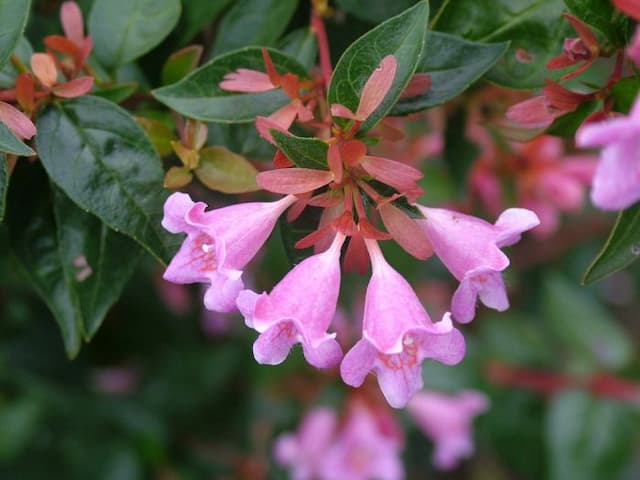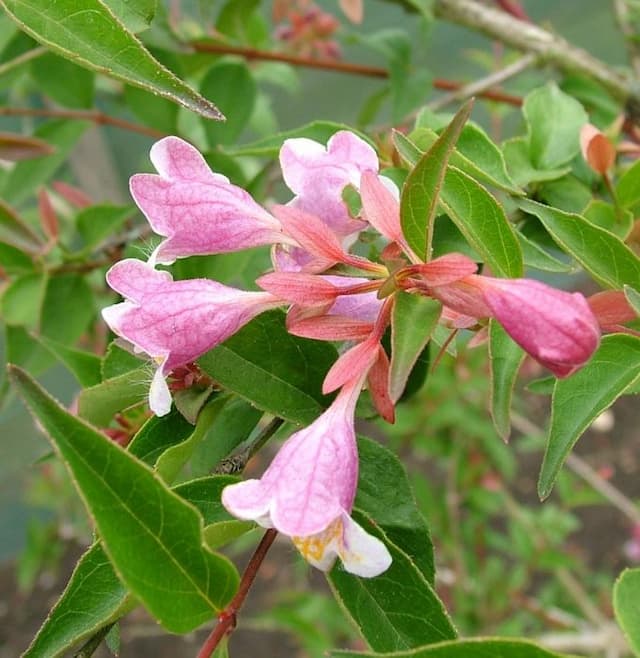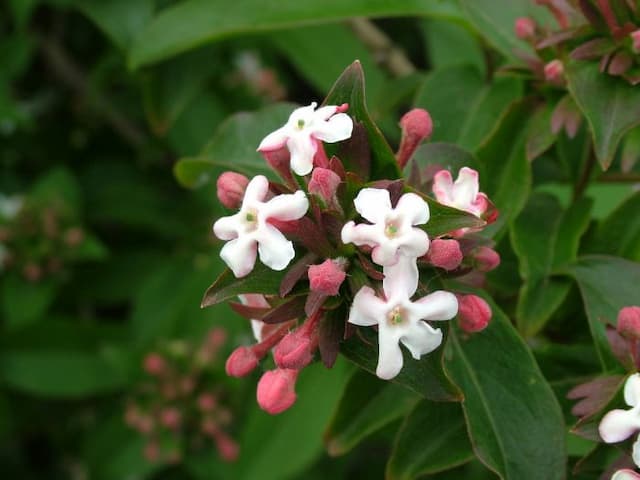Japanese Honeysuckle Lonicera japonica 'Mint Crisp' (PBR) (v)

ABOUT
Japanese Honeysuckle 'Mint Crisp' is a captivating plant that draws attention with its unique foliage and fragrant flowers. The plant is adorned with leaves that are a striking variegation of green and cream or yellow, giving them a minty fresh appearance that stands out in any garden setting. The bright green leaves have irregular edges that often blend into a creamy white or pale yellow, creating a marbling effect that is quite eye-catching. The variegation can vary between leaves, adding to the plant's charm. Amidst its attractive foliage, the Japanese Honeysuckle 'Mint Crisp' produces highly scented flowers, which are a brilliant white with a slight pink or purple hue as they mature. These tubular blossoms typically appear in pairs and display a delicate yet lush aesthetic. They are especially known for their intense fragrance, which is sweet and potent, often intensifying in the evening. As the seasons progress, this honeysuckle may also bear small, glossy berries that range in color from black to purple, adding another element of visual interest. The combination of its striking variegated leaves, enchanting flowers, and vibrant berries makes the Japanese Honeysuckle 'Mint Crisp' a standout plant in any landscape. Its intricate details and soothing color palette can bring a sense of serenity and natural beauty to gardens or outdoor spaces.
About this plant
 Names
NamesFamily
Caprifoliaceae
Synonyms
Japanese Honeysuckle 'Mint Crisp', Variegated Honeysuckle 'Mint Crisp', Hall's Japanese Honeysuckle 'Mint Crisp'.
Common names
Lonicera japonica 'Mint Crisp'.
 Toxicity
ToxicityTo humans
The most common common name for Lonicera japonica 'Mint Crisp' (PBR) (v) is Japanese Honeysuckle. This plant has components that can be toxic to humans if ingested in large quantities. Symptoms of poisoning from Japanese Honeysuckle can include gastrointestinal upset, such as nausea, vomiting, and diarrhea. In more severe cases, it may lead to more serious symptoms that could require medical attention. Therefore, it is advisable to avoid ingesting any part of the plant and to keep it out of the reach of children who might be tempted to taste it.
To pets
Japanese Honeysuckle has components that can be toxic to pets if they consume parts of the plant. Symptoms of toxicity in pets can be similar to those in humans and may include gastrointestinal upset with signs of nausea, vomiting, and diarrhea. Depending on the amount ingested, the pet could experience more severe symptoms, and veterinary care may be necessary. Pet owners should ensure that their pets do not have access to any part of the Japanese Honeysuckle plant to prevent accidental ingestion.
 Characteristics
CharacteristicsLife cycle
Perennials
Foliage type
Evergreen
Color of leaves
Variegated
Flower color
White
Height
10 feet (3 meters)
Spread
6 feet (1.8 meters)
Plant type
Climber
Hardiness zones
4-9
Native area
Japan
Benefits
 General Benefits
General Benefits- Aesthetic Appeal: Japanese honeysuckle 'Mint Crisp' is known for its attractive variegated foliage, which adds visual interest to gardens and landscapes.
- Fragrant Flowers: It produces sweetly scented white flowers that can bring a pleasant fragrance to outdoor spaces.
- Long Flowering Season: This plant often has a long flowering period, which can extend throughout the summer months.
- Attracts Wildlife: The flowers can attract pollinators such as bees and butterflies, promoting biodiversity in the garden.
- Growth Habit: With its twining vines, it can be used for vertical gardening, providing vertical interest and helping to cover trellises, arbors, or fences.
- Shade Tolerance: Japanese honeysuckle 'Mint Crisp' can tolerate partial shade, making it versatile for different garden locations.
- Low Maintenance: Once established, it generally requires minimal care, making it suitable for gardeners of all skill levels.
- Drought Tolerance: The plant has some degree of drought tolerance, reducing the need for frequent watering once it is well-established.
 Medical Properties
Medical Properties- Antibacterial: Japanese honeysuckle has been used in traditional medicine for its potential antibacterial properties.
- Anti-inflammatory: The plant may have anti-inflammatory effects that can help to reduce swelling and pain.
- Antiviral: There is some evidence that suggests the plant has antiviral properties, particularly against certain strains of influenza.
- Antioxidant: Japanese honeysuckle contains antioxidants which may help to protect cells from damage.
- Febrifuge: Traditionally, the plant has been used to reduce fevers.
- Soothing sore throats: The flowers and buds have been used in traditional remedies for soothing sore throats.
- Cooling agent: It's often used in herbal medicine to cool down the body and alleviate heat-related conditions.
 Air-purifying Qualities
Air-purifying QualitiesThis plant is not specifically known for air purifying qualities.
 Other Uses
Other Uses- Lonicera japonica 'Mint Crisp', commonly known as Japanese Honeysuckle, can be used as a natural dye source for textiles, imparting a range of yellowish colors depending on the mordant used.
- Its pliable stems can be woven into small decorative items such as baskets or even jewelry, exploiting its natural beauty in a different form.
- Gardeners sometimes use the long vines of Japanese Honeysuckle to create living supports or trellises for other plants, turning it into a functional part of the garden's architecture.
- When dried, the vines can also be used in the creation of homemade musical instruments like flutes, utilizing their hollow nature.
- The fragrant flowers can be placed in bowls of water to create a naturally scented room freshener or added to potpourri mixes.
- A strong infusion made from the leaves can serve as a natural insecticide for garden pests, offering an eco-friendly pest control solution.
- Japanese Honeysuckle can be used as a natural binding agent in papermaking, providing additional strength to handmade papers.
- The flowers, when dried, can be used as a natural filling for scented sachets, contributing their sweet scent to linens and clothing when stored.
- Pressed flowers and leaves of the plant can be utilized in art projects, such as botanical prints or inclusions in resin crafts, capturing the delicate features of the plant.
- Flower nectar, harvested sustainably, can sweeten teas and homemade beverages with a subtle floral undertone.
Interesting Facts
 Feng Shui
Feng ShuiThe Japanese Honeysuckle is not used in Feng Shui practice.
 Zodiac Sign Compitability
Zodiac Sign CompitabilityThe Japanese Honeysuckle is not used in astrology practice.
 Plant Symbolism
Plant Symbolism- Devotion: Lonicera japonica, commonly known as Japanese honeysuckle, is often symbolizing devoted love due to its ability to strongly attach to objects and other plants. This characteristic mirrors the idea of being dedicated and closely bonded in a relationship.
- Generosity: The way Japanese honeysuckle abundantly covers walls and fences can be seen as a symbol of generosity, as it freely shares its beauty and fragrance.
- Bonding: The interwoven nature of the honeysuckle's vines can represent the strong bonds of friendship or family, signifying unity and togetherness.
- Affection: With its sweet-smelling flowers that bloom prolifically, the Japanese honeysuckle is often associated with the tenderness and affection one might have for another person.
- Happiness: The delightful scent and nectar-rich flowers can be symbols of happiness and enjoyment, as they bring joy to people and are a favorite amongst hummingbirds and butterflies.
 Water
WaterJapanese Honeysuckle 'Mint Crisp' should be watered when the top inch of the soil feels dry to the touch. Water deeply, ensuring that the water penetrates the soil to reach the root zone. During the growing season, this might mean watering once or twice a week, depending on weather conditions. It's best to use roughly 1 gallon of water for each watering session to thoroughly saturate the root area. In winter, reduce watering frequency, as the plant's water requirements decrease.
 Light
LightJapanese Honeysuckle 'Mint Crisp' thrives best in full sun to partial shade. Ideally, place it in a spot where it receives direct sunlight for at least 6 hours daily. However, in regions with very hot summers, some afternoon shade is beneficial to prevent scorching of the leaves.
 Temperature
TemperatureJapanese Honeysuckle 'Mint Crisp' is hardy and can tolerate a range of temperatures. It can survive minimum temperatures down to about 0 degrees Fahrenheit and is comfortable in summer temperatures up to around 90 degrees Fahrenheit. The ideal temperature range for optimal growth is between 60 and 80 degrees Fahrenheit.
 Pruning
PruningPrune Japanese Honeysuckle 'Mint Crisp' to maintain shape, encourage bushier growth, and remove any dead or tangled branches. The best time for pruning is in late winter or early spring before new growth begins. Pruning can be performed annually, but if the plant becomes overgrown, more frequent pruning may be needed.
 Cleaning
CleaningAs needed
 Soil
SoilJapanese Honeysuckle 'Mint Crisp' thrives in soil that is well-draining, fertile, and retains moisture without becoming waterlogged. A mix of garden soil, compost, and a bit of perlite or sand can create a good environment for this plant. Aim for a soil pH between 5.5 and 7.5 for optimal growth.
 Repotting
RepottingJapanese Honeysuckle 'Mint Crisp' typically doesn't require frequent repotting. Repotting every 2 to 3 years is sufficient unless the plant has outgrown its container or the soil has degraded, in which case it may need repotting sooner.
 Humidity & Misting
Humidity & MistingJapanese Honeysuckle 'Mint Crisp' isn't particularly fussy about humidity but performs best in moderate to high humidity levels. Aiming for approximately 40-60% relative humidity will support its growth.
 Suitable locations
Suitable locationsIndoor
Place near bright window, avoid direct strong sunlight.
Outdoor
Plant in sun or part shade, protect from strong winds.
Hardiness zone
4-9 USDA
 Life cycle
Life cycleLonicera japonica 'Mint Crisp', commonly known as Mint Crisp Japanese Honeysuckle, begins its life cycle as a seed, which upon finding favorable conditions, germinates and sends out shoots and roots. As a fast-growing vine, it enters a vegetative stage where it develops foliage—characteristically variegated leaves—and elongates its stems, using other structures or supports to climb. During spring and summer, the plant enters the flowering stage, producing fragrant white flowers that gradually turn yellow, attracting pollinators. After pollination, these flowers develop into black berries which are dispersed by animals or gravity, leading to the potential establishment of new plants. In regions with cold winters, Lonicera japonica 'Mint Crisp' may undergo a period of dormancy where growth slows and the plant conserves energy until favorable conditions return. Given suitable conditions, it can grow and spread for many years, often requiring management to control its growth due to its potential invasiveness.
 Propogation
PropogationPropogation time
Early Spring
The most popular method for propagating Lonicera japonica 'Mint Crisp', commonly known as the Japanese Honeysuckle, is through softwood cuttings. This process typically occurs in the spring to early summer, when new growth is green and flexible. To propagate, one would cut a section of the plant that is around 4 to 6 inches (10 to 15 centimeters) long, with several leaves attached. The lower leaves should be removed, and the cut end dipped into a rooting hormone to encourage root growth. The cutting is then placed in a well-draining soil mix, ensuring high humidity and indirect light. Roots usually develop within a few weeks, after which the new plant can eventually be transplanted into the garden.







![Himalayan honeysuckle [Golden Lanterns]](/_next/image?url=https%3A%2F%2Fplants-admin.emdemapps.com%2Fimages%2Fplants%2F%2Fimages%2F604b55302cc87.png&w=640&q=75)

